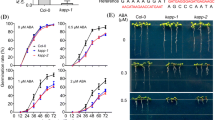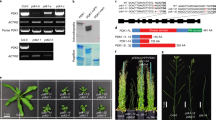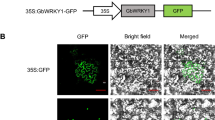Abstract
ARIA is an ARM repeat protein that is a positive regulator of ABA response. To identify ARIA-interacting proteins, we conducted yeast two-hybrid screening. One of the positive clones obtained from the screen encoded a protein kinase, AtNEK6, which belongs to the NIMA (Never In Mitosis, gene A)-related kinase family. We analyzed AtNEK6 over-expression (OX) and knockout (KO) lines to investigate its in vivo function. The AtNEK6 OX lines grew slowly, whereas the KO line germinated and grew faster than wild type plants. AtNEK6 also affected ABA and stress responses. During seed germination, AtNEK6 OX lines were hypersensitive to ABA and high osmolarity, whereas its KO line was partially insensitive to ABA and high osmolarity. Previously, AtNEK6 was shown to be involved in epidermal cell morphogenesis. Our results indicate that AtNEK6 is also involved in plant growth regulation and responses to ABA and high osmolarity during the seed germination stage.
Similar content being viewed by others
References
Bechtold, N., and Pelletier, G. (1998). In planta Agrobacterium-mediated transformation of adult Arabidopsis thaliana plants by vacuum infiltration. Methods Mol. Biol. 82, 259–266.
Choi, H., Hong, J., Kang, J., and Kim, S.Y. (2000). ABFs, a family of ABA-responsive element binding factors. J. Biol. Chem. 21, 1723–1730.
Cloutier, M., Vegneault, F., Lachance, D., and Séguin, A. (2005). Characterization of a poplar NIMA-related kinase PNek1 and its potential role in meristematic activity. FEBS Lett. 579, 4659–4665.
Finkelstein, R.R., Gampala, S.S., and Rock, C.D. (2002). Abscisic acid signaling in seeds and seedlings. Plant Cell 14, S15–S45.
Fujii, H., Chinnusamy, V., Rodrigues, A., Rubio, S., Antoni, R., Park, S.Y., Cutler, S.R., Sheen, J., Rodriguez, P.L., and Zhu, J.K. (2009). In vitro reconstitution of an abscisic acid signalling pathway. Nature 462, 660–664.
Hayward, D.G., and Fry, A.M. (2005). Nek2 kinase in chromosome instability and cancer. Cancer Lett. 237, 155–166.
Hirayama, T., and Shinozaki, K. (2007). Perception and transduction of abscisic acid signals: keys to the function of the versatile plant hormone ABA. Trends Plant Sci. 12, 343–351.
Jefferson, R.A., Kavanagh, T.A., and Bevan, M.W. (1987). GUS fusions: β-glucuronidase as a sensitive and versatile gene fusion marker in higher plants. EMBO J. 20, 3901–3907.
Kang, J., Choi, H., Im, M., and Kim, S.Y. (2002). Arabidopsis basic leucine zipper proteins that mediate stress-responsive abscisic acid signaling. Plant Cell 14, 343–357.
Kim, S.Y. (2006). The role of ABF family bZIP class transcription factors in stress response. Physiologia Plantarum 126, 519–527.
Kim, S., Choi, H., Ryu, H.J., Park, J.H., Kim, M.D., and Kim, S.Y. (2004). ARIA, an Arabidopsis arm repeat protein interacting with a transcriptional regulator of abscisic acid-responsive gene expression, is a novel abscisic acid signaling component. Plant Physiol. 136, 3639–3648.
Kreps, J.A., Wu, Y., Chang, H.S., Zhu, T., Wang, X., and Harper, J.F. (2002). Transcriptome changes for Arabidopsis in response to salt, osmotic, and cold stress. Plant Physiol. 130, 2129–2141.
Lee, S., Cho, D., Kang, J., and Kim, S.Y (2009). An ARIA-interacting AP2 domain protein is a novel component of ABA signaling. Mol. Cells 27, 409–416.
Ma, Y., Szostkiewicz, I., Korte, A., Moes, D., Yang, Y., Christmann, A., and Grill, E. (2009). Regulators of PP2C phosphatase activity function as abscisic acid sensors. Science 324, 1064–1068.
Motose, H., Tominaga, R., Wada, T., Sugiyama, M., and Watanabe, Y. (2008). A NIMA-related protein kinase suppresses ectopic outgrowth of epidermal cells through its kinase activity and the association with microtubules. Plant J. 54, 829–844.
Murashige, T., and Skoog, F. (1962). A revised medium for rapid growth and bioassay with tobacco tissue culture. Physiol. Plant 15, 473–497.
Osmani, S.A., and Ye, X.S. (1996). Cell cycle regulation in Aspergillus by two protein kinases. Biochem. J. 317, 633–641.
Pandey, S., Nelson, D.C., and Assmann, S.M. (2009). Two novel GPCR-type G proteins are abscisic acid receptors in Arabidopsis. Cell 136, 136–148.
Park, S.Y., Fung, P., Nishimura, N., Jensen, D.R., Fujii, H., Zhao, Y., Lumba, S., Santiago, J., Rodrigues, A., Chow, T.F., et al. (2009). Abscisic acid inhibits type 2C protein phosphatases via the PYR/PYL family of START proteins. Science 324, 1068–1071.
Pnueli, L., Gutfinger, T., Hareven, D., Ben-Naim, O., Ron, N., Adir, N., and Lifschitz, E. (2001). Tomato SP-interacting proteins define a conserved signaling system that regulates shoot architecture and flowering. Plant Cell 13, 2687–2702.
Ramon, M., Rolland, F., and Sheen, J. (2008). Sugar Sensing and Signaling. The Arabidopsis Book. e1–22.
Sakai, T., Honing, H., Nishioka, M., Uehara, Y., Takahashi, M., Fujisawa, N., Saji, K., Seki, M., Shinozaki, K., Jones, M.A., et al. (2008). Armadillo repeat-containing kinesins and a NIMA-related kinase are required for epidermal-cell morphogenesis in Arabidopsis. Plant J. 53, 157–171.
Schroeder, J.I., Kwak, J.M., and Allen, G.J. (2001). Guard cell abscisic acid signaling and engineering drought hardiness in plants. Nature 410, 327–330.
Takahashi, S., Seki, M., Ishida, J., Satou, M., Sakurai, T., Narusaka, M., Kamiya, A., Nakajima, M., Enju, A., Akiyama, K., et al. (2004). Monitoring the expression profiles of genes induced by hyperosmotic, high salinity, and oxidative stress and abscisic acid treatment in Arabidopsis cell culture using a full-length cDNA microarray. Plant Mol. Biol. 56, 29–55.
Uno, Y., Furihata, T., Abe, H., Yoshida, R., Shinozaki, K., and Yamaguchi-Shinozaki, K. (2000). Arabidopsis basic leucine zipper transcription factors involved in an abscisic acid-dependent signal transduction pathway under drought and high-salinity. Proc. Natl. Acad. Sci. USA 97, 11632–11637.
Vigneault, F., Lachance, D., Cloutier, M., Pelletier, G., Levasseur, C., and Séguin, A. (2007). Members of the plant NIMA-related kinases are involved in organ development and vascularization in poplar, Arabidopsis and rice. Plant J. 51, 575–88.
Xiong, L., Schumaker, K.S., and Zhu, J.-K. (2002). Cell signaling during cold, drought, and salt stress. Plant Cell 14, S165–183.
Yamaguchi-Shinozaki, K., and Shinozaki, K. (2005). Organization of cis-acting regulatory elements in osmotic- and cold-stress-responsive promoters. Trends Plant Sci. 10, 88–94.
Author information
Authors and Affiliations
Corresponding author
About this article
Cite this article
Lee, Sj., Cho, DI., Kang, Jy. et al. AtNEK6 interacts with ARIA and is involved in ABA response during seed germination. Mol Cells 29, 559–566 (2010). https://doi.org/10.1007/s10059-010-0070-7
Received:
Revised:
Accepted:
Published:
Issue Date:
DOI: https://doi.org/10.1007/s10059-010-0070-7




